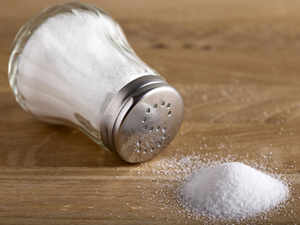
“We lost half of March and all of April… That’s over 40 days at peak of the season. In salt production, loss of one mid-summer month is comparable with other industries losing four critical months,” says Bharat Raval, president of Indian Salt Manufacturers Association.
Mumbai: There’s a good chance, the salt-shaker on your dining table may go empty in the months to come. “Salt farmers” along the Indian coastline are predicting a shortfall in stock as the Covid-related lockdown has truncated a large part of the production cycle. Labour shortage, absence of transportation and inter-district travel restrictions have prompted producers to stall work at many salt works.
The salt-manufacturing season stretches between October and mid-June – with maximum production taking place in March and April. Gujarat, Rajasthan, Andhra Pradesh and Tamil Nadu account for nearly 95 per cent of the production while Maharashtra, Odisha and West Bengal chip in with smaller quantities – taking the national tally to about 200 – 250 lakh tonnes of salt every year.
“We lost half of March and all of April… That’s over 40 days at peak of the season. In salt production, loss of one mid-summer month is comparable with other industries losing four critical months,” says Bharat Raval, president of Indian Salt Manufacturers Association (ISMA).
Indians consume 95 lakh tonnes of edible salt every year; demand from industry ranges between 110 – 130 lakh tonnes while 58 - 60 lakh tonnes are exported to countries that are fully dependent on India for salt. Industrial salt is used by power plants, oil refineries, solar power companies, chemical manufacturers, textile makers, metal foundries, pharmaceuticals, rubber and leather manufacturers.
“We’re not sure if we’ll be able to make up for the lost time… we just have about 45 days now. Each production cycle takes about 60 to 80 days - depending on the precipitation levels in a particular place,” says Raval.
“If we’re not able to ramp up production over the next few days, our off-season (monsoon) buffer stock may not be much. Also, if there’s a spike in demand from industries post-lockdown, it may get a bit challenging,” he adds.
Only delayed rains can save the day for salt manufacturers. Beyond that, there should not be many pre-monsoon showers or cyclones hitting shorelines over the next two months.
“We started the current season late as rains extended till late-November. Now if there’re early rains, as predicted, it may not be possible for salt manufacturers to pile up a thick buffer stock,” says P. R. Dhruve, a Jamnagar-based salt manufacturer and secretary of ISMA.
Though classified as an essential commodity, salt production has been severely impacted on account of strict state-level lockdown rules. Most salt-producing states have asked industrial units to remain shut and have curbed surface transport. Inter-district travel has also been restricted. An email query sent to the Salt Commissioner (under Department for Promotion of Industry And Internal Trade) seeking clarifications has not been answered at the time of going to press.
Salt manufactures in Gujarat, Andhra Pradesh and Tamil Nadu employ labour from backward districts or other states to work in the fields. Several of these workmen have gone back to their homes now, says ISMA members.
“Most salt pans are in the interiors – in other districts. We’re not able to transport labour to our worksites. In fact, we’re not even getting sufficient workmen now,” says Dhruve.
Gujarat produces 75 - 80 per cent of salt in India; of this, a lion’s share comes from the Kutch region. Topographically, Kutch is arid, open-landed and less populated than other regions in the State. It also receives less rainfall, late into the season. This may allow Kutch-based salt farmers to recover the lost time. But for now, salt production has been marginally impacted in Kutch too, ISMA members opine.
“Longer rainy season (last year) and the lockdown has impacted production; there’s a decline in new stock currently. But we’re trying to ramp up production... We’re asking our workmen to stay near salt pans now,” says Bachubhai Ahir, a Kutch-based manufacturer.
According to ISMA members, there are over 12,500 salt works in India, and over 80 per cent of them operate in the unorganized sector. Over 70 per cent of salt production come from unorganized players. Many of these players supply raw salt to large manufacturers such as Tatas, Grasim, Chougules and Nirma. Limited options to transport salt to factory gates is also hampering production, says ISMA members.
“Many of these companies are in shutdown phase currently… Some of them have their factories in Covid hotspots such as Ahmedabad,” says Dhruve.
While “salt farmers” are predicting a shortfall, manufacturers like Tatas are hoping to keep the supply lines up and running. Tatas, which retails Tata Salt, claims to be running their operations at normal rates without any shortfall in production.
“Our current stocks and the planned operations would be sufficient for off-season period too,” says Shohab Rais, COO - Indian chemicals business at Tata Chemicals.
“We don't see any significant shortage of salt in the coming months – apart from minor issues in local availability due to administrative restrictions on account of Covid,” he says.
Nobody knows for sure, if salt-shakers would run dry - or not - in the coming months. It's best to take both farmers and manufacturers with a pinch of salt - at least for now.
No comments:
Post a Comment